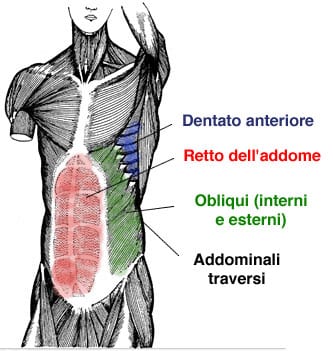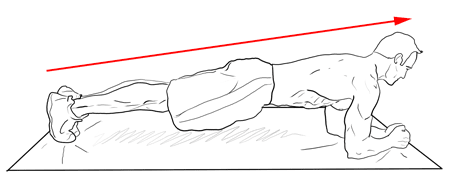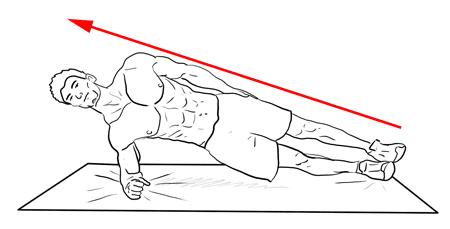By the healthiergang writer Edoardo Laudi, personal trainer and majoring in Exercise and Sports Sciences
Types of Abs: What Are They and How to Develop Them?
In this article we talk about different muscles that make up our abdomen and how to develop them through targeted exercises. After a brief insight into the different types of abs, we will detail a training program to engage and strengthen them all.
A little bit of anatomy
 The rectus abdominis muscle it is innervated by the last six intercostal nerves and the hypogastric ileus nerve. By contracting, it lowers the ribs, thereby acting like an expiratory muscle, flexes the chest over the pelvis (or vice versa), and increases abdominal pressure.
The rectus abdominis muscle it is innervated by the last six intercostal nerves and the hypogastric ileus nerve. By contracting, it lowers the ribs, thereby acting like an expiratory muscle, flexes the chest over the pelvis (or vice versa), and increases abdominal pressure.
The transverse abdominal muscle it is innervated by the intercostal nerves (T8-T12) and by the iliohypogastric and ileoinguinal nerves (L1). By contracting, it brings in the ribs, thus acting as an expiratory muscle, and increases the abdominal pressure. Widely used in the discipline of Yoga.
It is placed deeply in the internal oblique muscle and has transverse course bundles. The internal oblique muscle of the abdomen is innervated by the last intercostal nerves (T8-T12) and by the ileohypogastric and ileoinguinal nerves (L1). Like the external oblique muscle of the abdomen, with its action it lowers the ribs, thus acting as an expiratory muscle, it flexes the chest but rotates it on its side. In addition, it also causes an increase in abdominal pressure.
The external oblique muscle of the abdomen it is innervated by the intercostal nerves (T5-T12) and by the ileohypogastric and ileoinguinal nerves (L1). Like the internal oblique muscle of the abdomen, with its action it lowers the ribs, thus acting as an expiratory muscle, it flexes the chest but rotates it to the opposite side. In addition, it also causes an increase in abdominal pressure.
It is located in the anterior and lateral walls of the abdomen and goes up the lateral chest wall. It looks like a large flattened sheet, quadrilateral in shape.
It originates from the external face of the last eight ribs by means of digitations of which the first five or six cross with those of the anterior serratus muscle and the last three with those of the great dorsal muscle. (1)
Core Strenght e Functional
core strength we mean the training of strength, balance and stability of all the muscles of the trunk. It means training not only the rectus abdominis, but all the muscles that come into play in the complex balance of the back, pelvis and buttocks.
The muscles involved in this specific type of training are varied and include: rectus abdominis, transverse abdominals, internal and external obliques, paravertebral, lumbar, small and large psoas and trapezius. Training the core has numerous advantages for both the advanced athlete and the normal client. A good core protects you from the many problems to which the back is subject in today's sedentary life. Greatly improving posture and stability of the spine.
In athletic training they are a real must, as the core comes into play in practically all movements!
Surely the plank and its variations are great exercises to include in a training routine. Having to keep the body in a straight line for a few seconds, this allows you to train and strengthen all the core muscles.
Front Plank
Lie prone on the floor (or mat), lean on your elbows, which will be shoulder-width under your chest, and on your toes. Contract your core to create a straight line. Hold this position for at least 30 seconds or up to a minute if you are just starting outRecovery time between sets of at least 30 seconds or 45 seconds. Let us remember well to exhale all the air by contracting all the muscles of the core.

Side Shelf
Lie on your side, with your upper body weight held on your elbow. Then try to imitate a straight line along the body by contracting all the necessary muscles. Hold this position for at least 30 seconds or up to a minute if you are just starting out. Do this exercise on both sides of the body. Muscles mostly called are internal and external oblique.

Front Plank variation
Once the ability to perform is developed the front and side plank exercises you can try, in addition to increasing the time under tension, adding some variants. For example, while doing the front plank, try to raise one arm or leg (or together an opposite arm and leg, for example, left arm, right leg).

Other operational advice
-If possible, try these exercises in front of a mirror. Thus you will have constant feedback of your correct form of execution.
-Use a suitable clock or timer. If you think everything will be fine by counting the seconds in your head, you will find that as you become more tired you will start counting faster.
-Going forward, be sure to gradually increase the time under tension. Increase by 510 seconds per week each position. (2)
HOW TO DEVELOP THE CORE
-Beginner: try to familiarize yourself with the first two exercises, getting as close as possible to the ideal and most suitable position for the exercise. Tension time at least from 15 seconds to 30 seconds.
-Intermediate: once the exercise has been well controlled, by consolidating the movement we can also use the third exercise by coordinating the limbs well. Tension time at least 15 seconds.
-Advanced: having learned all three exercises well, you can play through a functional circuit with all three exercises and trying to reach the maximum of your possibilities, also reducing recovery times.
References
(1) AMBROSI G., CASTANO P. (2006) Anatomy of man, Edi Ermes Edizioni.
(2) STECCHI A. (2004), Biomechanics of physical exercises. From athletic training to fitness, Elika.


























